Discover the Best Board Games for Every Player

Family Adventures: Board Games for All Ages to Enjoy
Looking for board games that bring your family together? Whether you're planning a cozy game night or searching for a new favorite, this guide highlights 10 great options for all ages. From quick, fun games like Bananagrams to strategy-packed classics like Ticket to Ride, there's something for everyone. Here's what to consider:
- Quick Picks for Busy Families: Short games like Kingdomino (15–20 min) and Tsuro (15–20 min) fit into tight schedules.
- Budget-Friendly Options: Affordable games like Ghost Blitz ($12.99) and Qwirkle ($19.99) deliver hours of fun without breaking the bank.
- Cooperative vs. Competitive: Choose teamwork with Richard Scarry's Busytown Eye Found It, or enjoy friendly competition with classics like Clue and Apples to Apples Junior.
- Replayability: Games like Quacks of Quedlinburg and Ticket to Ride offer endless variety with fresh strategies every time.
Quick Comparison
| Game Name | Ages | Play Time | Players | Style | Price (USD) |
|---|---|---|---|---|---|
| Ticket to Ride | 8+ | 30–60 min | 2–5 | Competitive | $49.99 |
| Richard Scarry's Busytown Eye Found It | 3+ | 15–20 min | 2–4 | Cooperative | $19.99 |
| Clue | 8+ | 45–60 min | 3–6 | Competitive | $11.99 |
| Apples to Apples Junior | 12+ | 30–45 min | 4–10 | Competitive | $19.99 |
| Quacks of Quedlinburg | 10+ | 45–60 min | 2–4 | Competitive | $49.99 |
| Kingdomino | 8+ | 15–20 min | 2–4 | Competitive | $19.99 |
| Bananagrams | 7+ | 10–15 min | 1–8 | Competitive | $14.99 |
| Tsuro: The Game of the Path | 8+ | 15–20 min | 2–8 | Competitive | $29.99 |
| Ghost Blitz | 8+ | 15–30 min | 2–8 | Competitive | $12.99 |
| Qwirkle | 6+ | 30–45 min | 2–4 | Competitive | $19.99 |
These games are perfect for fostering connection, teaching skills like problem-solving, and creating lasting memories. Ready to find your next family favorite? Dive in!
Top 10 Family Board Games – 2024
What Makes a Great Family Board Game?
When it comes to creating unforgettable family moments, some board games truly stand out. But what exactly makes a board game perfect for all ages? The best family board games shine because they master a few essential elements.
Simple rules with broad appeal are a must. A great game is one that can entertain a 7-year-old and a 40-year-old alike. This happens when the mechanics are easy to grasp but offer hidden depth for more experienced players. If you can explain the rules in 3-5 minutes, you’re off to a great start - no one wants to lose interest before the game even begins.
A mix of luck and strategy is key to keeping everyone engaged. Games that rely entirely on strategy can frustrate younger players, while games based solely on luck may bore those who enjoy a challenge. The best family games strike a balance - skill matters, but a lucky break can still change the outcome.
Playtime that fits your family’s attention span is another critical factor. Most families find that games lasting 20-45 minutes hit the sweet spot. It’s long enough for adults to enjoy but short enough to hold the attention of younger players.
Themes that appeal to all generations make a big difference. Broadly relatable themes - like building railways, solving mysteries, or exploring magical kingdoms - tend to bring everyone together. Games that focus on niche interests might leave some players feeling left out.
Replayability is what separates a game you play once from one you’ll want to revisit again and again. Games with variable setups, multiple strategies, or just enough randomness ensure that no two sessions feel exactly the same.
For American families, practical details matter too. Games should fit comfortably on a standard dining room table, store easily, and be reasonably priced - making them a great go-to for family entertainment.
Flexible player counts add versatility. The best games work just as well on a quiet weeknight with two or three players as they do during a holiday gathering with the whole extended family.
Lastly, emotional engagement is what makes a game truly unforgettable. Whether it’s the excitement of a close finish, the joy of solving a puzzle together, or the laughter sparked by a surprising twist, these moments create lasting memories. They’re the stories you’ll retell long after the game is over.
With these qualities in mind, it’s time to dive into some of the top family board games that check all the boxes.
1. Ticket to Ride

Ticket to Ride turns a cross-country train adventure into an exciting board game where players compete to build railway routes across America. It's easy for newcomers to pick up while still offering enough depth to keep seasoned players hooked.
The game revolves around collecting colored train cards to claim routes between cities. Points are earned by completing destination tickets, which challenge players to connect distant cities like Seattle to Miami or New York to Los Angeles. Timing is everything - you’ll need to decide whether to secure key routes early or take risks with additional destination cards for higher rewards. What starts as simple card collection quickly escalates into a tense competition for prime routes.
As the game progresses, the stakes rise. That critical connection through Chicago might suddenly become a hotly contested area, forcing players to rethink their strategies on the fly.
Broad Age Appeal
Ticket to Ride draws players of all ages by capturing the charm of train travel and exploration. Its vibrant map and straightforward mechanics make it accessible to kids as young as 8, while adults can dive into its deeper strategic layers.
For younger players, the focus is often on completing destination tickets and aiming for the longest route bonus. Meanwhile, more experienced players might develop blocking strategies or carefully manage their card draws to maximize efficiency. The colorful design and detailed map create an inviting experience that keeps everyone engaged.
Replayability
Every game of Ticket to Ride feels fresh thanks to its random destination tickets and variable card draws. Players start with different goals, and the shared card market means you’ll need to act fast to grab the cards you need before someone else does.
The game’s replay value increases with the variety of maps available in the Ticket to Ride series. While the original USA map offers plenty of space and flexibility, versions like Europe introduce new mechanics like ferries and tunnels, adding fresh tactical challenges. This variety ensures that families can keep discovering new strategies and combinations.
Competitive Gameplay Options
Although Ticket to Ride is competitive at its core, it’s designed to keep the experience lighthearted and family-friendly. Players race to complete routes efficiently, and while blocking an opponent’s path is possible, there are usually alternative routes available. This balance keeps everyone engaged and ensures that the competition remains fun rather than frustrating.
The strategic interactions - whether racing for a critical route or planning around an opponent’s moves - create memorable moments that bring families closer together.
U.S. MSRP (Affordability)
At $54.99, Ticket to Ride offers excellent value for its quality components and engaging gameplay. The sturdy cards and durable plastic train pieces are built to withstand countless game nights, making it a worthwhile addition to any family’s collection.
Beyond its entertainment value, Ticket to Ride serves as a perfect introduction to modern board gaming. For families looking to branch out from classics like Monopoly or Scrabble, it’s an investment that opens the door to a whole new world of gaming fun.
2. Richard Scarry's Busytown Eye Found It
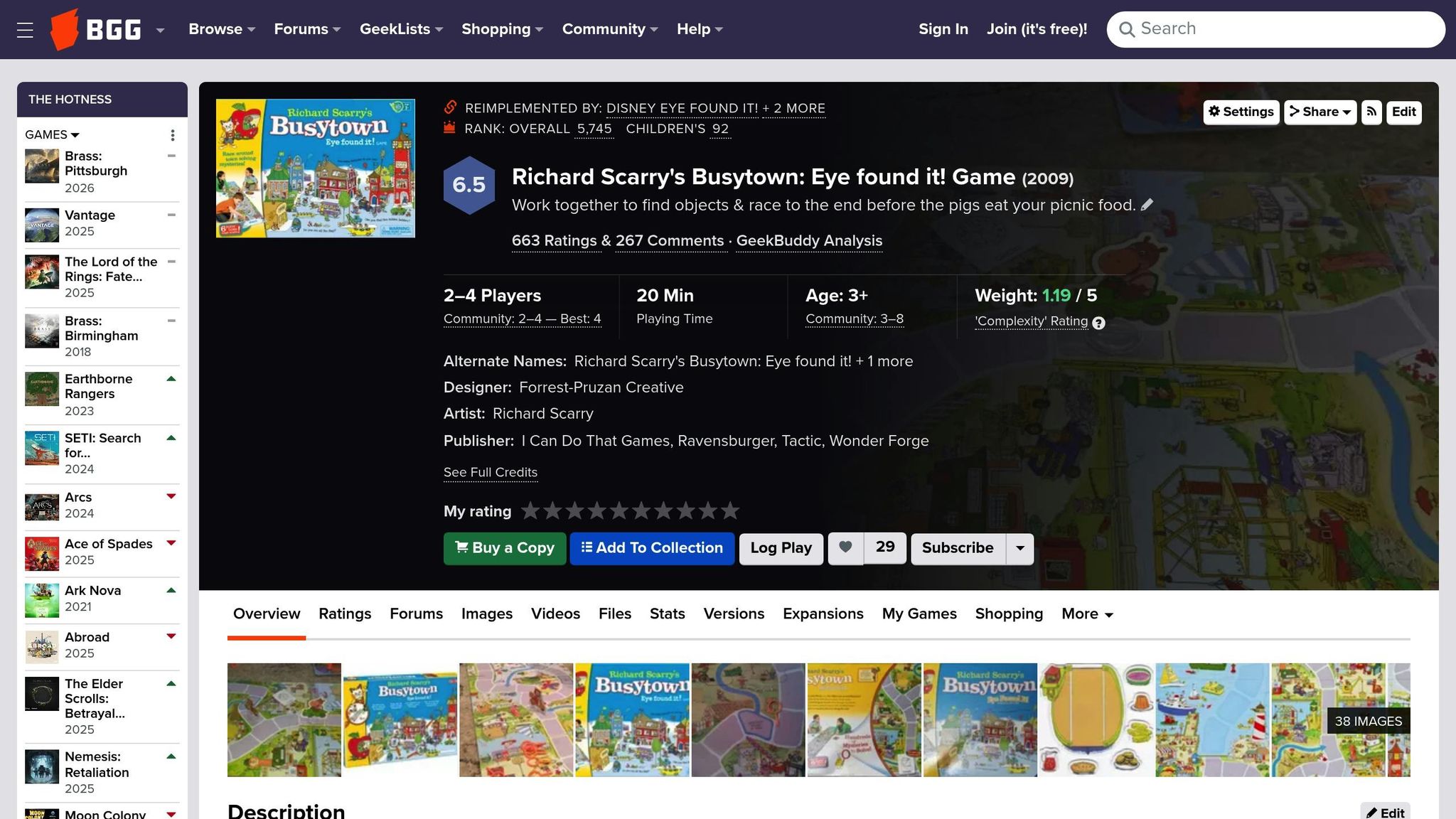
Richard Scarry's Busytown Eye Found It transforms beloved children's books into an engaging board game that brings families together. The goal? Help Lowly Worm reach Picnic Island before the pigs ruin the feast! This interactive adventure is played on a large, colorful game board, where players team up to uncover hidden objects and navigate through the whimsical world of Busytown.
The gameplay blends hidden-object challenges with teamwork, making it feel more like a shared adventure than a traditional board game. Players spin a spinner to move along the board, stopping at various locations to search for hidden items using magnifying glasses. The artwork, true to Richard Scarry's iconic style, features familiar faces like Huckle Cat, Sergeant Murphy, and Mr. Frumble, adding a touch of nostalgia for parents and delight for kids.
Everyone at the table stays involved. While one player might be hunting for a tiny shoe in the bakery scene, others can assist or get ready for the next challenge. The cooperative nature ensures there's no pressure on any single player - success is all about teamwork.
Broad Age Appeal
This game’s vibrant design is perfect for families with kids aged 3 to 8, but it’s also fun for older siblings and adults. Younger children can jump in by spotting objects they recognize, even if they’re not ready to read the cards. Meanwhile, older players can take on trickier challenges, like finding smaller or more cleverly hidden items, and help guide the search.
Preschoolers might focus on spotting big, obvious objects like cars or animals, while school-age kids enjoy the thrill of tracking down the harder-to-find items. And don’t be surprised if adults become just as invested - sometimes even more competitive - when it comes to finding those elusive details.
For parents who grew up with Richard Scarry's books, the game offers a nostalgic trip down memory lane. It often sparks conversations about favorite Busytown characters and stories, creating a multi-generational connection that adds to the fun.
Cooperative Gameplay Options
Busytown Eye Found It is all about shared victories. Either the team gets Lowly Worm to Picnic Island, or they don’t - there’s no “winner takes all” dynamic here. This cooperative approach eliminates the tears and frustration that can sometimes come with competitive games, especially for younger players.
The game also teaches valuable lessons about teamwork and communication. Families naturally develop strategies, like dividing search areas or assigning specific object types to different players. When someone spots a particularly tricky hidden item, the excitement is felt by everyone at the table.
To keep things fresh, the game offers adjustable difficulty levels through different card sets. This flexibility means families can tailor the challenge to their group’s abilities, making it a game that grows with the players over time.
U.S. MSRP (Affordability)
Priced at $19.99, Richard Scarry's Busytown Eye Found It delivers excellent value for families looking for fun, quality entertainment. The oversized game board and detailed illustrations make the price feel well worth it, especially considering how often families are likely to play.
The components are built to last, with a sturdy board that can handle repeated unfolding and folding, and magnifying glasses that add an extra layer of fun. For families wanting to expand their game collection without spending a fortune, this is a fantastic choice for cooperative gaming.
3. Clue
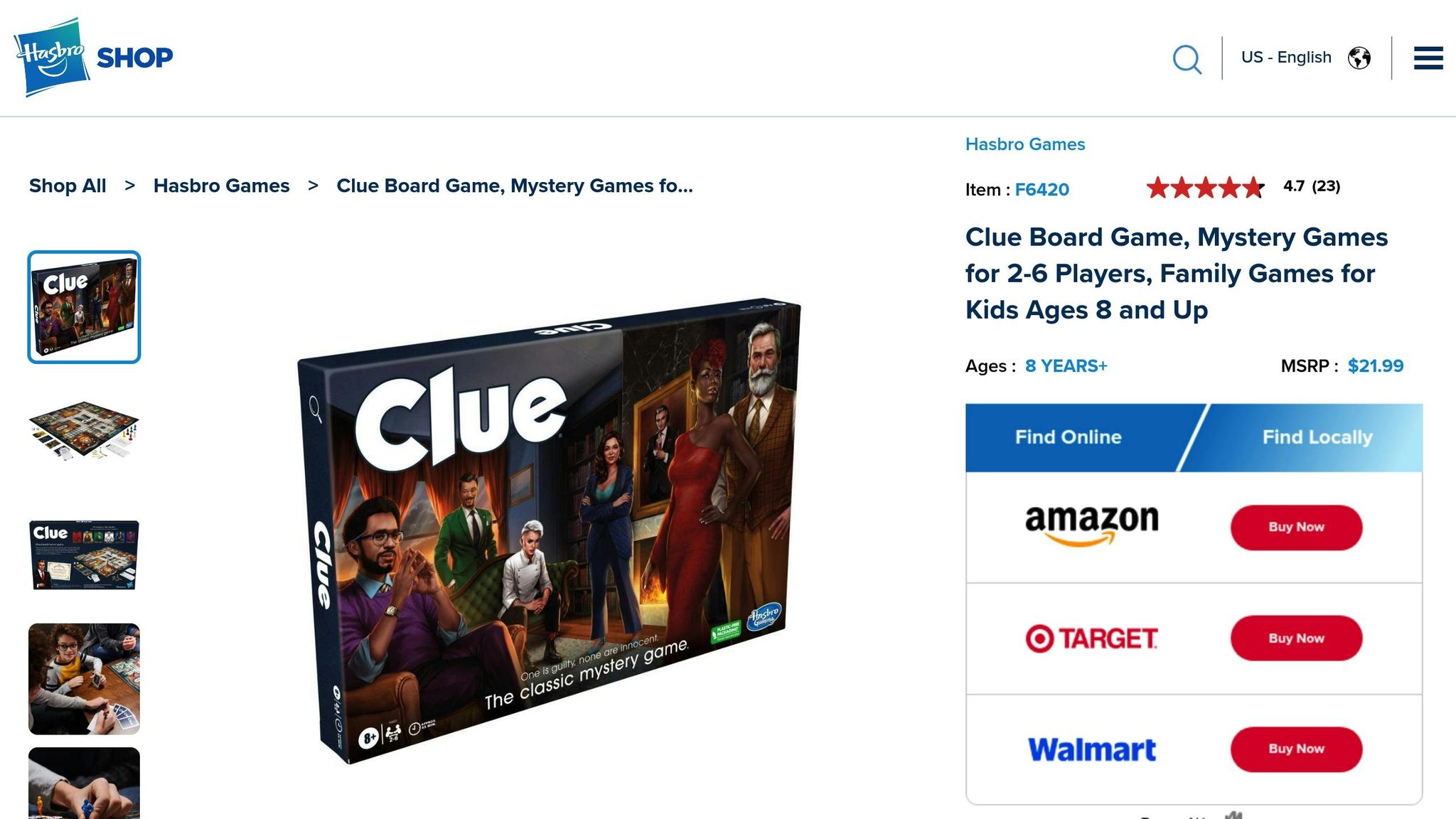
Clue brings the thrill of mystery-solving straight to your family game night with its classic "whodunit" format. Players take on the roles of suspects in a crime, moving through the mansion’s various rooms to gather clues and crack the case. The goal? Figure out who committed the crime, with what weapon, and where it happened.
The gameplay is simple enough for kids to follow but layered enough to keep adults intrigued. Players roll dice, make suggestions, and use deduction to eliminate possibilities. Each player holds secret cards that provide critical hints, weaving a web of clues that gradually leads to the solution.
What makes Clue such a hit with families is how it naturally fosters logical thinking and teamwork. Kids sharpen their questioning skills, while adults can guide younger players without spoiling the fun. The Victorian mansion setting and colorful characters - like Colonel Mustard and Miss Scarlet - add a touch of drama, sparking imagination and bringing the story to life.
Broad Age Appeal
Clue is officially recommended for ages 8 and up, but younger players can join in with a little guidance. Elementary-aged kids love the challenge of solving the mystery while practicing logic, and teens and adults enjoy the strategic depth of reading opponents’ moves. Whether you're captivated by the character-driven storytelling or focused solely on solving the puzzle, Clue offers something for everyone in the family.
This flexibility ensures that each person can approach the game in their own way, making it a favorite for players of all ages. It’s one of those rare games that grows with your family, offering new experiences every time you play.
Replayability
One of Clue’s standout features is its endless replayability. Each game starts with a new combination of solution cards, guaranteeing a fresh mystery every time. Families often create their own traditions - like dramatic accusations or inventing quirky backstories for the characters - that add an extra layer of fun and creativity. While themed editions of Clue exist, the classic version remains the most versatile and timeless option for family play.
Competitive Gameplay Options
Clue strikes a perfect balance between strategy and fun. It’s a competitive game that rewards sharp deductive reasoning rather than luck. The suspense builds as players make accusations, and even if you lose, it just means the mystery outsmarted you this time. For families who prefer a more collaborative approach, Clue can easily be adapted into a team effort, where everyone works together to solve the case as quickly as possible.
U.S. MSRP (Affordability)
Priced at $21.99 in the U.S., Clue from Hasbro is an affordable addition to any family game collection. While themed versions can cost up to $44.99, the classic edition offers fantastic value, delivering the core experience that has entertained families for generations. At under $25, Clue provides hours of entertainment while encouraging logical thinking and deduction, making it a must-have for family game nights. Its combination of affordability and engaging gameplay ensures it remains a beloved choice for families everywhere.
4. Apples to Apples Junior
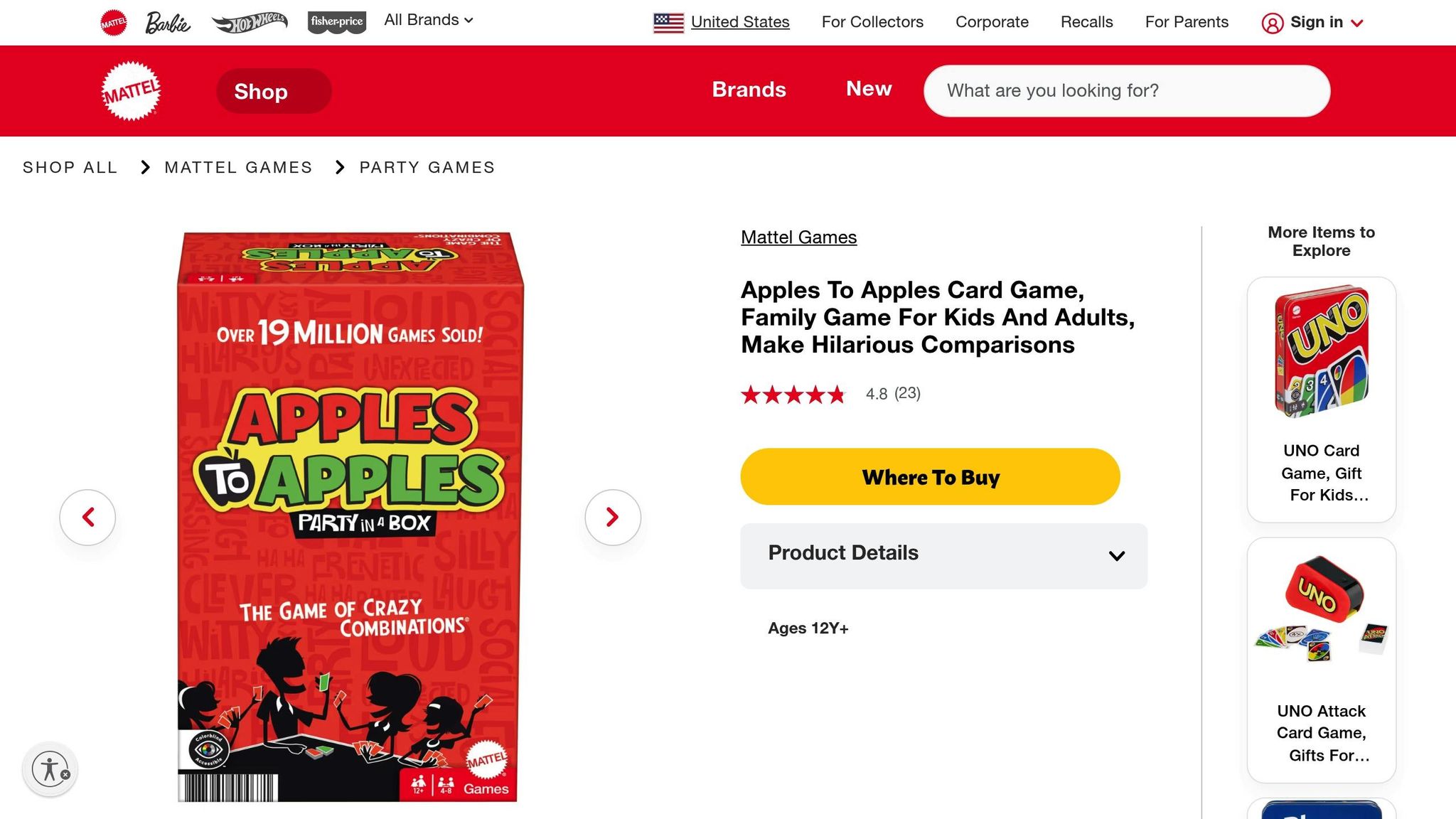
Apples to Apples Junior takes the classic comparison card game and gives it a playful twist, perfect for kids and families. This version keeps the fun intact while making it accessible for younger players, ensuring moments of shared laughter and imaginative thinking. Players match cards to descriptive prompts, often leading to hilarious and unexpected pairings.
The rules are simple: one player acts as the judge, reading a descriptive card aloud. The other players then choose a card from their hand that they think best fits the description. The judge selects the card they find most amusing or fitting. There’s no “right” or “wrong” answer - every round is a celebration of creativity and humor.
The junior edition is designed with kids in mind, featuring age-appropriate content. Cards include relatable and familiar topics like pizza, puppies, superheroes, and snow days, making it easy for children to join in the fun. This approachable format makes it a go-to choice for family game nights.
Broad Appeal Across Ages
Though officially recommended for ages 9 and up, the game’s simple rules and recognizable themes make it enjoyable for a wide range of players. From young children to grandparents, everyone can bring their own perspective to the table, making it a fantastic option for multi-generational gatherings.
Endless Replayability
One of the game’s highlights is its ability to feel fresh every time you play. With a large variety of cards, no two rounds are ever the same. Families often add their own flair, like explaining why they chose a particular card or acting out their selections, which only adds to the fun. This flexibility ensures that game nights stay lively and unpredictable.
Play It Your Way: Competitive or Cooperative
Traditionally, Apples to Apples Junior is played as a competitive game, but it can easily be adapted for cooperative play. Whether you’re keeping score or just enjoying the process of picking the funniest or most creative matches, the game encourages interaction and sparks engaging conversations.
Budget-Friendly Fun
This card game is known for being an affordable option that doesn’t skimp on entertainment. For families looking for a game that combines fun, creativity, and replay value, Apples to Apples Junior is an excellent choice that brings everyone together without breaking the bank.
5. Quacks (Quacks of Quedlinburg)
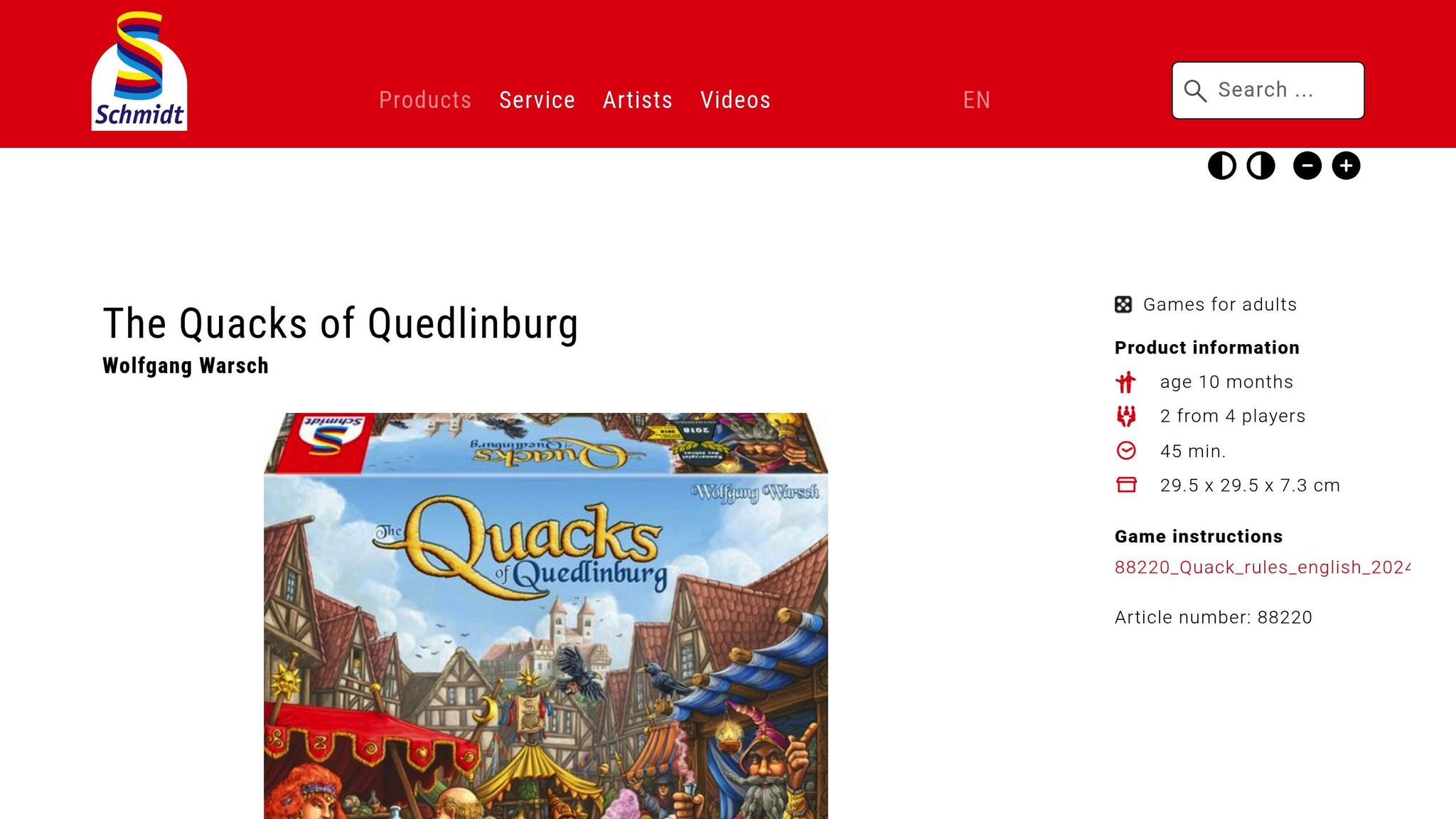
Quacks of Quedlinburg takes you into the world of medieval alchemy, where players become quack doctors brewing potions with ingredient chips. This bag-building game is a fun mix of strategy and luck. The goal? Draw ingredient chips to create potions - but go too far with risky chips, and your potion might explode, cutting your turn short.
The game’s risk-versus-reward mechanics add a layer of excitement to every turn. As you pull ingredients, the tension builds - should you push your luck for a stronger potion or stop while you’re ahead? These moments of suspense keep everyone engaged, creating a lively atmosphere as players cheer daring moves or laugh when a potion blows up.
Perfect for Family Play
What makes Quacks ideal for families is its simultaneous play. Everyone draws chips and builds their potions at the same time, so there’s no waiting around for your turn. This format keeps kids focused and the game moving smoothly, which parents will appreciate. Plus, the colorful components not only look great but also make the game more engaging and fun to play.
Great for All Ages
The game is officially recommended for players aged 10 and up, but younger kids can easily join in with a little guidance. The basic mechanics - drawing chips and adding them to your potion - are simple enough for kids to understand quickly. At the same time, the strategic choices, like deciding which ingredients to buy or when to stop drawing, offer enough depth to keep adults interested. This balance makes it a hit for family game nights.
Another family-friendly feature is the scoring system, which rewards both careful planning and bold risks. Even if a potion explodes, players still make progress, keeping younger participants motivated and the overall mood upbeat.
Endless Replayability
One of the best parts of Quacks is how every game feels fresh. The lineup of ingredient chips available for purchase changes each time, ensuring new challenges and strategies with every playthrough. The bag-building mechanic also evolves as you add ingredients, shifting probabilities and opening up fresh opportunities. This variety means no two games are ever the same, making it a game you’ll want to revisit again and again.
Price and Value
In the U.S., Quacks of Quedlinburg typically costs $45–$50, placing it in the mid-range for family board games. While it’s more expensive than a simple card game, the high-quality components and endless replayability make it worth the investment. The sturdy player boards, durable chips, and well-designed ingredient elements are built to handle plenty of family use.
For families looking for a game that will become a long-term favorite, Quacks delivers excellent value. With its engaging gameplay and lasting appeal, it’s a purchase that pays off over months - or even years - of fun family nights.
6. Kingdomino
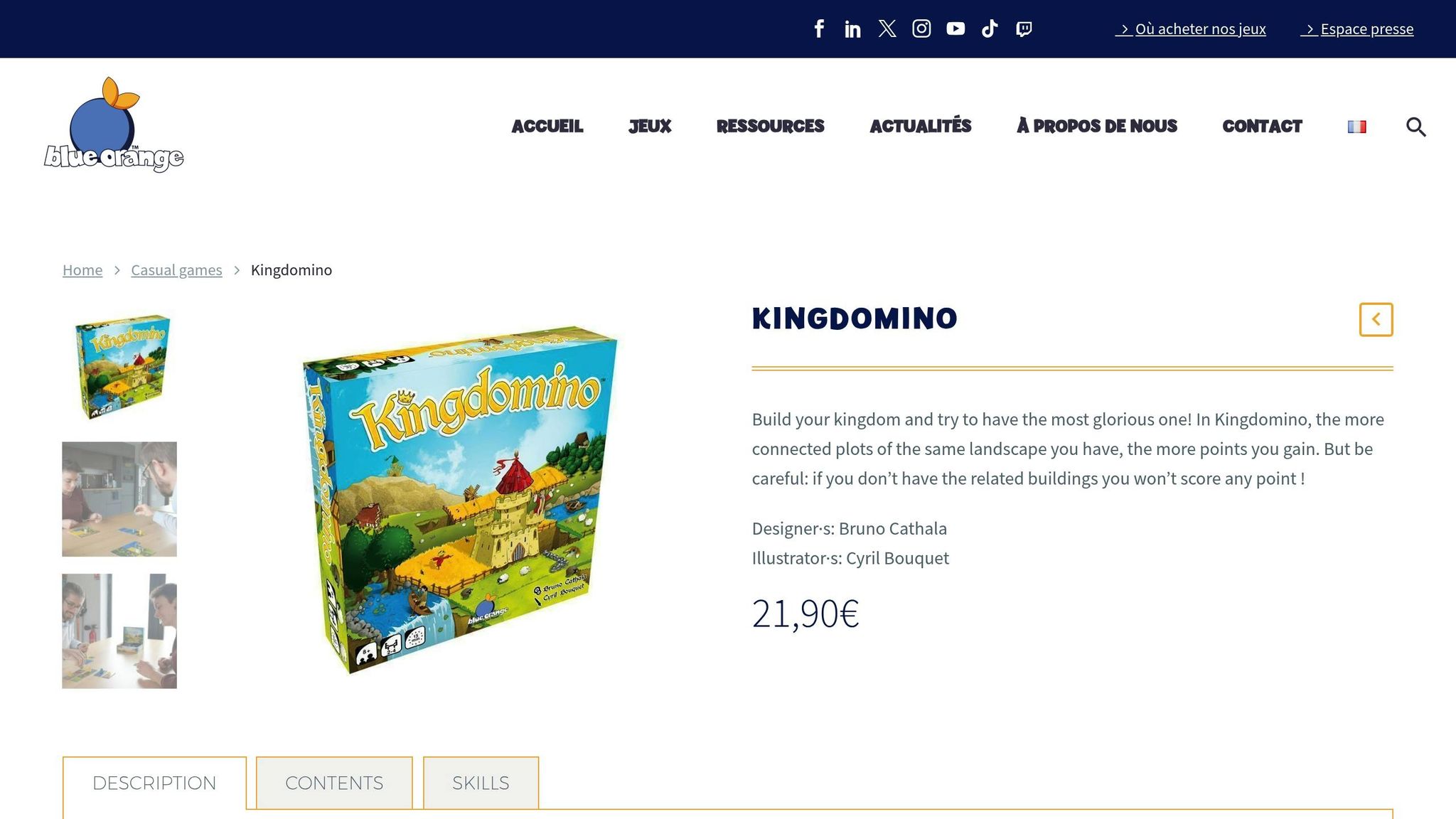
Kingdomino takes the classic concept of dominoes and transforms it into a strategic adventure of kingdom-building. In this game, players draft vibrant domino tiles featuring different terrains - like forests, grasslands, lakes, and mines - to create their own 5x5 kingdoms. The objective? Connect matching terrains and gather crowns to rack up the highest score.
What makes Kingdomino stand out is its clever drafting mechanic. Each round, players select tiles in turn, but the tile you pick also determines your position in the next round. This adds a layer of strategy as you weigh immediate benefits against future opportunities.
Having won the prestigious Spiel des Jahres award, Kingdomino has earned its place as a beloved family game that bridges the gap between generations. Its straightforward rules and engaging gameplay make it a hit with players of all ages.
Fun for All Ages
One of Kingdomino's greatest strengths is its universal appeal. The rules are simple enough for kids as young as 4 or 5 to understand, especially since no reading is required. Families can even tweak the rules to accommodate younger players, such as allowing more flexible tile placement instead of strictly adhering to the 5x5 grid. This ensures that everyone, from kids to adults, can enjoy the game together. Unlike simplified "junior" versions of other games, Kingdomino retains enough strategic depth to keep older players engaged while still being accessible for younger ones.
Endless Variety
Kingdomino offers a fresh experience every time you play, thanks to its randomized tile distribution. The game includes 48 domino tiles, but only a portion is used in each session. In two-player games, for example, half the tiles are removed at the start, creating new strategic possibilities with every round.
The mix of terrains also adds to the game's replay value. Rare terrains, like mines with multiple crowns, appear less often, while common terrains, such as forests, offer more consistent scoring options. This unpredictability forces players to adapt their strategies, keeping the gameplay exciting. Optional variants, like expanding the grid or adding bonus scoring for specific placements, add even more variety to the experience.
Affordable and Durable
With a U.S. MSRP of about $20, Kingdomino delivers exceptional value. The components are built to last, from the thick cardboard tiles to the sturdy player boards, ensuring the game can handle countless family game nights. For the price, it’s a fantastic addition to any game collection, offering hours of fun without breaking the bank.
Whether you’re new to board games or a seasoned player, Kingdomino is a perfect choice. It’s easy to learn, fun to play, and offers just the right amount of challenge to bring everyone around the table together.
sbb-itb-1ed942f
7. Bananagrams
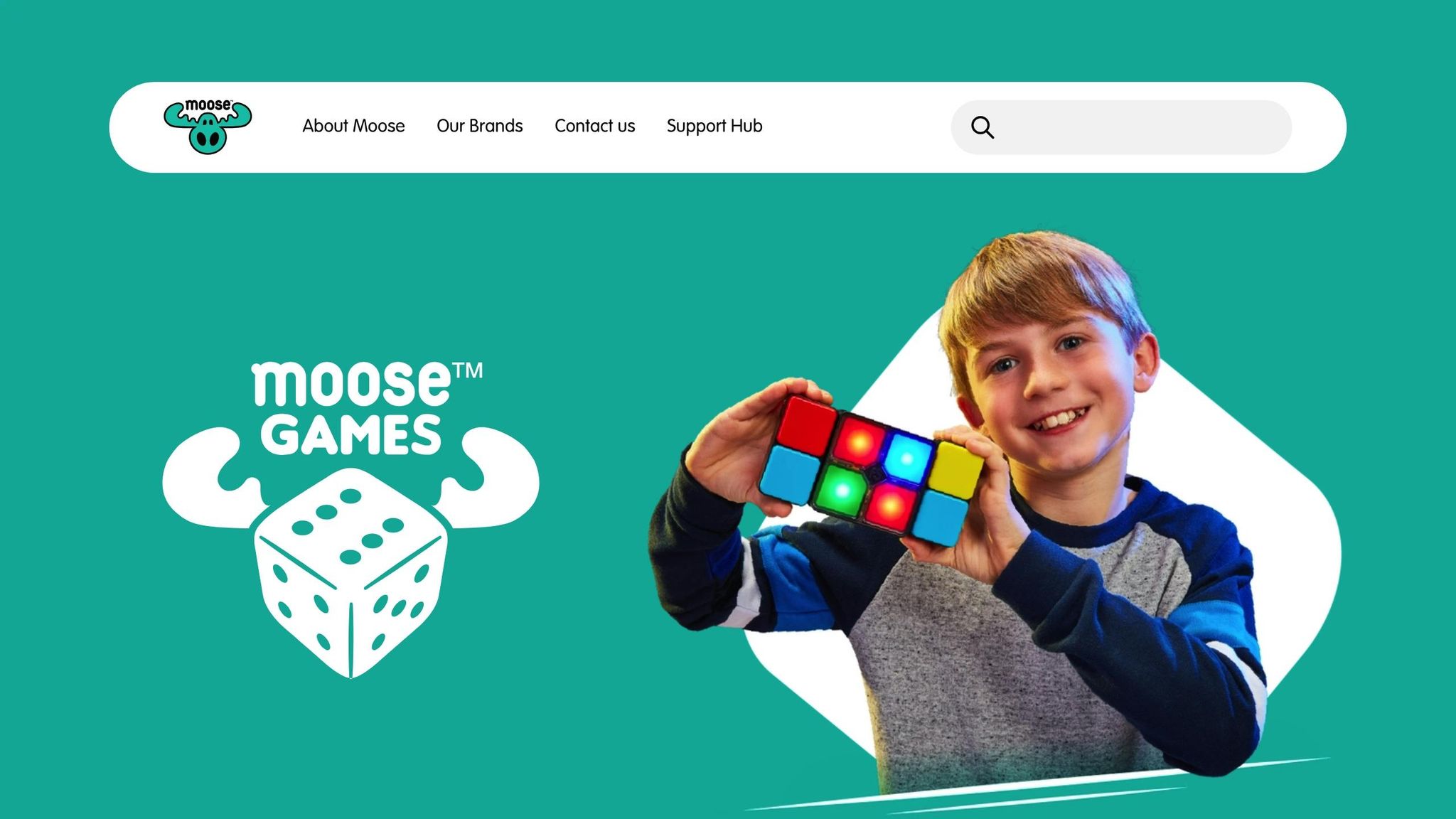
Bananagrams is a fast-paced, tile-based word game that ditches the traditional board for a more flexible, portable experience. Players race to build their own crossword-style grids using letter tiles, all while keeping up with the game's energetic pace. Its signature banana-shaped pouch not only makes it easy to recognize but also perfect for taking on family trips or game nights.
What makes Bananagrams stand out is its straightforward gameplay. Each player starts with a set number of letter tiles and works simultaneously to create connected words. Whenever a player uses all their tiles, they yell "Peel!" - prompting everyone to draw another tile. The action keeps going until there are no tiles left in the center, and the first player to complete their grid wins. This constant movement and excitement make it a hit for players of all ages.
Fun for All Ages
Bananagrams is suitable for anyone aged 7 and up, making it a great choice for families. Kids can jump in without feeling left out, while adults stay engaged thanks to the game's quick pace. It accommodates 1–8 players, so whether you're having a quiet evening or hosting a larger group, it's a perfect fit. Plus, since there's no board involved, everyone can focus on their own grid while still sharing in the fun of the competition.
Always Fresh, Always Fun
The magic of Bananagrams lies in its replayability. The game doesn't rely on randomized setups; instead, the interactions between players keep things exciting. As iloveregex, a Top 1% Commenter on r/boardgames, put it:
I also think short games such as Bananagrams and Sushi Go Party are replayable also.
Another user, R0cketsauce, added:
I think the real random element is what your opponents decide to do.
Each round feels new, as players create unique word grids every time. With rounds lasting just 10–15 minutes, you can easily squeeze in multiple games in one sitting.
Competitive and Educational
Bananagrams thrives on its fast-paced, competitive nature. Players rely on quick thinking and a solid vocabulary to complete their grids, making it both fun and accessible. While it doesn’t require elaborate strategies, it’s a fantastic way to sharpen spelling and word-building skills for players of all ages.
Affordable Fun
Priced between $15.60 and $15.99 for the Classic Edition, Bananagrams offers great value for families. With over 26,000 Amazon reviews and an impressive 4.9 out of 5-star rating, it’s clear that players love this game. The durable tiles and convenient pouch make it a long-lasting addition to any game collection, whether you’re playing at home or on the go.
8. Tsuro: The Game of the Path
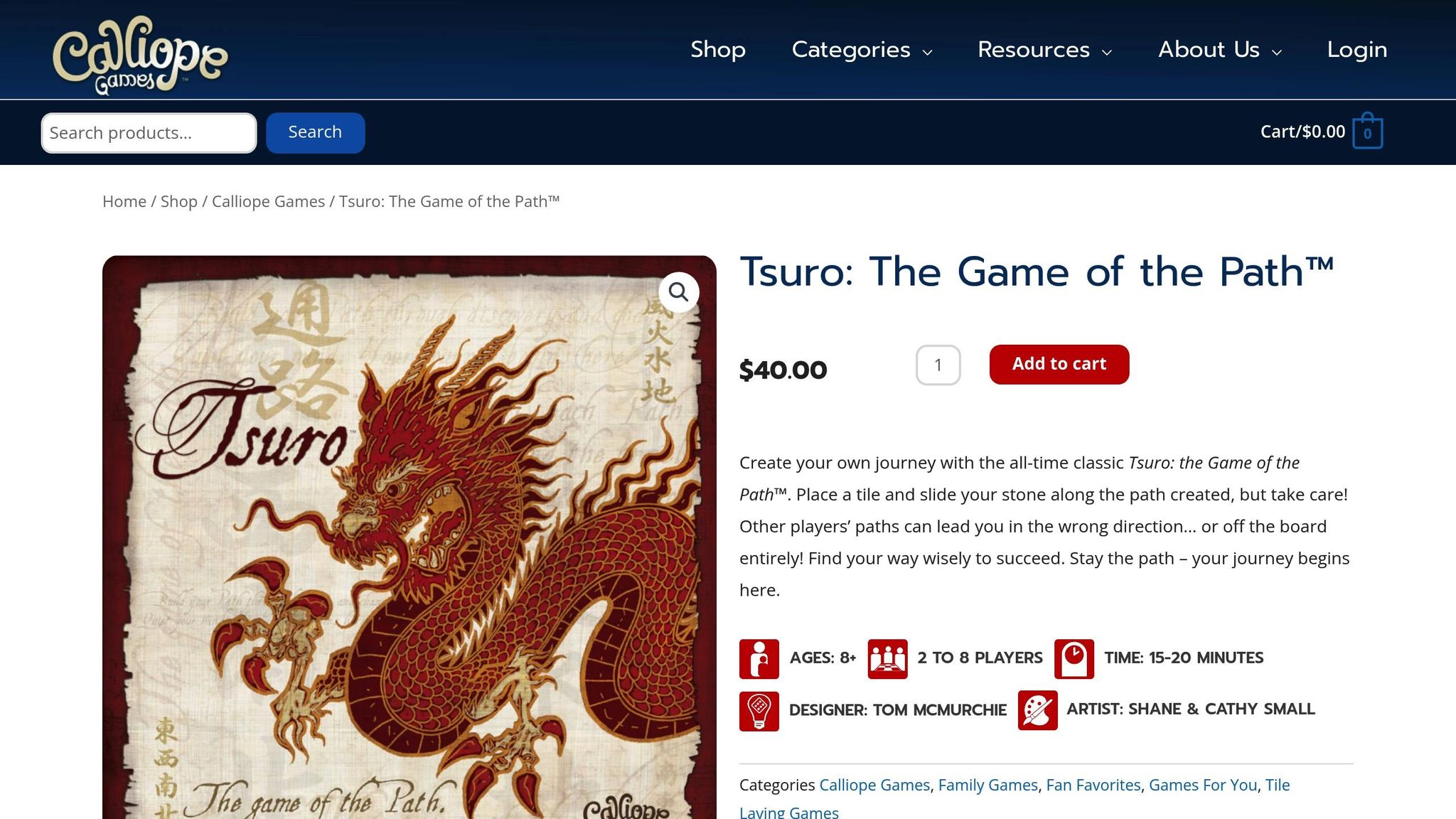
Tsuro: The Game of the Path is a beautifully designed strategy game where players guide their colored stones along intricate paths, aiming to outlast their opponents. With its roots in ancient Asian art, the game offers a calming yet engaging experience that's as pleasing to look at as it is to play.
The rules are straightforward. Each player begins with a stone on the edge of the board and takes turns placing tiles to extend their path. The twist? Every tile placement not only advances your own journey but also reshapes the board for everyone else. As the game progresses and the board fills up, paths inevitably cross, forcing players to think carefully about where to place their tiles to stay in the game.
What makes Tsuro especially appealing is how accessible it is. The clear visual rules and simple mechanics make it a great choice for families, with players as young as 8 able to join in without much guidance. Younger kids can easily grasp the gameplay, as each tile clearly shows how it will affect the board. There’s no hidden information or overly complicated rules to worry about, making it a smooth experience for all ages.
With room for 2–8 players, Tsuro is versatile enough for small family gatherings or larger game nights. Each session lasts just 15–20 minutes, ensuring it holds the attention of younger players and leaves room for multiple rounds. The short playtime also encourages experimentation with different strategies or simply enjoying the relaxing process of creating intricate path designs.
While Tsuro is competitive at its core - players aim to be the last stone standing - it manages to keep the competition light. Much of the gameplay depends on tile draws and the ever-changing board, so it rarely feels like players are directly targeting one another. Instead, the game fosters a sense of collective creativity as everyone contributes to an evolving maze. Even moments of tension, like when paths converge and players face tricky decisions, feel exciting rather than confrontational, making it a great choice for families who prefer games that emphasize fun over conflict.
At around $35.00, Tsuro offers excellent value. The game’s components are high-quality, with sturdy tiles and satisfying wooden stones that enhance the tactile experience. Its timeless design and versatility make it a staple for quick rounds or the centerpiece of a casual game night. Plus, the stunning artwork ensures it looks as good on the table as it does on your shelf.
Whether you’re looking for a quick filler game or something to anchor your family game night, Tsuro delivers. Its blend of simplicity, strategy, and visual appeal means it’s likely to become a regular favorite rather than an overlooked addition to your collection.
9. Ghost Blitz
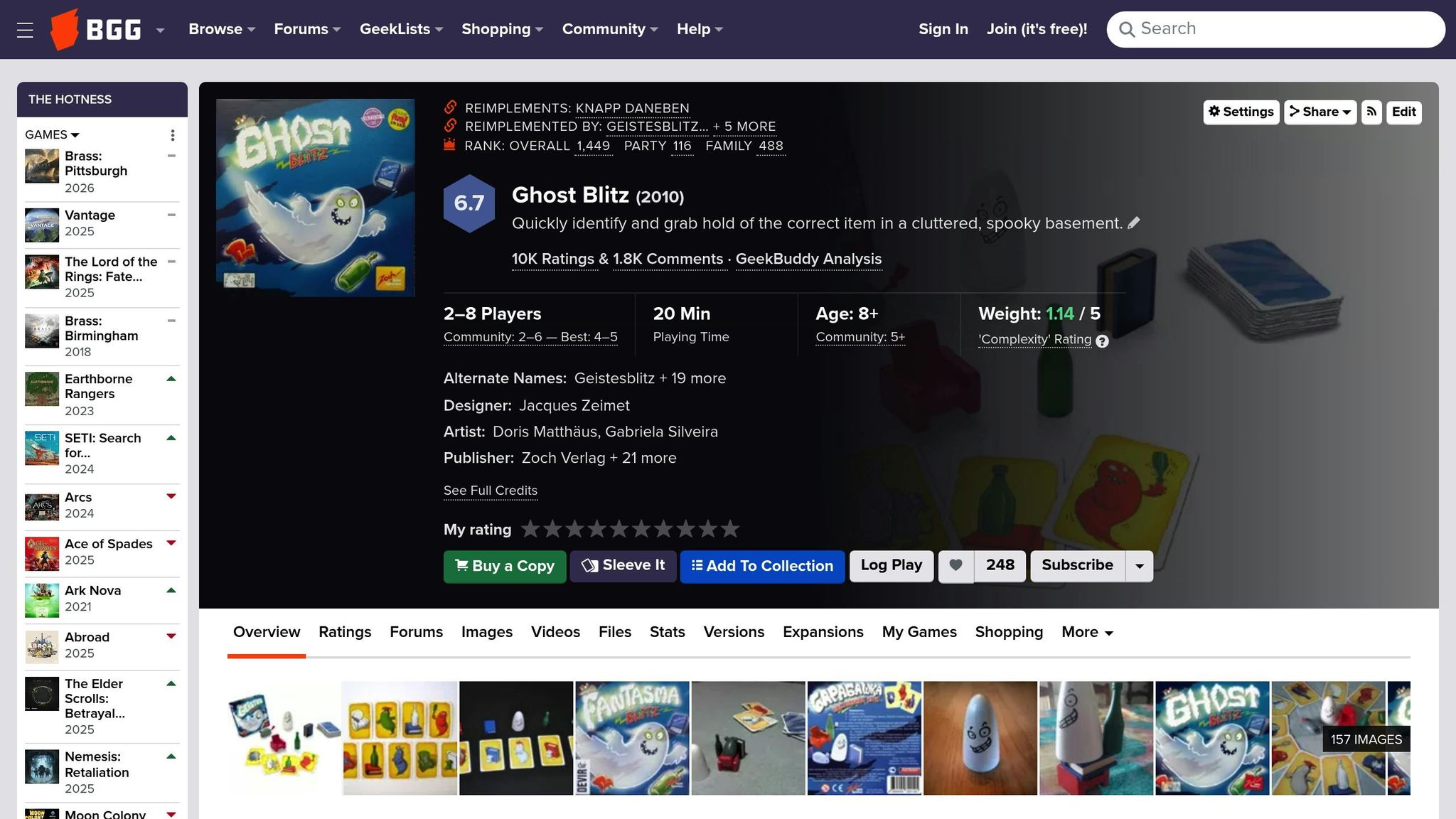
Ghost Blitz turns a simple recognition game into a fast-paced frenzy that leaves everyone laughing and scrambling. The concept is straightforward: five colorful objects - a white ghost, a red chair, a green bottle, a blue book, and a gray mouse - are at the center of the action. Players flip cards that feature one or more of these objects, and the challenge is to either grab the object that matches the card exactly or the one that's missing when the colors don’t align.
What makes Ghost Blitz so engaging is how it bridges the gap between generations. While adults might overthink their choices, kids often rely on quick instincts, making it anyone’s game. The clatter of pieces hitting the table and the chaotic grab for the right item create an infectious energy. Even those who usually shy away from games can’t resist joining in. It’s a game that naturally draws everyone together, regardless of age or experience.
Broad Age Appeal
Ghost Blitz’s charm lies in its simplicity, making it accessible to a wide range of ages. While it’s recommended for players 8 and up, younger kids can easily join with minor adjustments. The game’s visual focus means no reading is required - just the ability to recognize colors and shapes. Teenagers often thrive on the fast decision-making, but younger players frequently steal the show with their lightning-fast reactions. And when adults overanalyze, it creates hilarious moments of role reversal, making this a perfect pick for family gatherings.
Replayability
With rounds lasting just 10–15 minutes, Ghost Blitz is perfect for quick, repeat play sessions. The random card draws ensure that every round feels fresh and unpredictable, keeping players on their toes and eager for more.
Competitive or Cooperative Gameplay Options
While Ghost Blitz is traditionally a competitive game - players racing to snatch the right object - families often tweak the rules for variety. Some choose a cooperative approach, working together to beat a timer or solve challenges, while others organize team-based tournaments for a mix of collaboration and friendly competition. Whatever the setup, the game’s flexibility adds layers of fun for any group dynamic.
10. Qwirkle
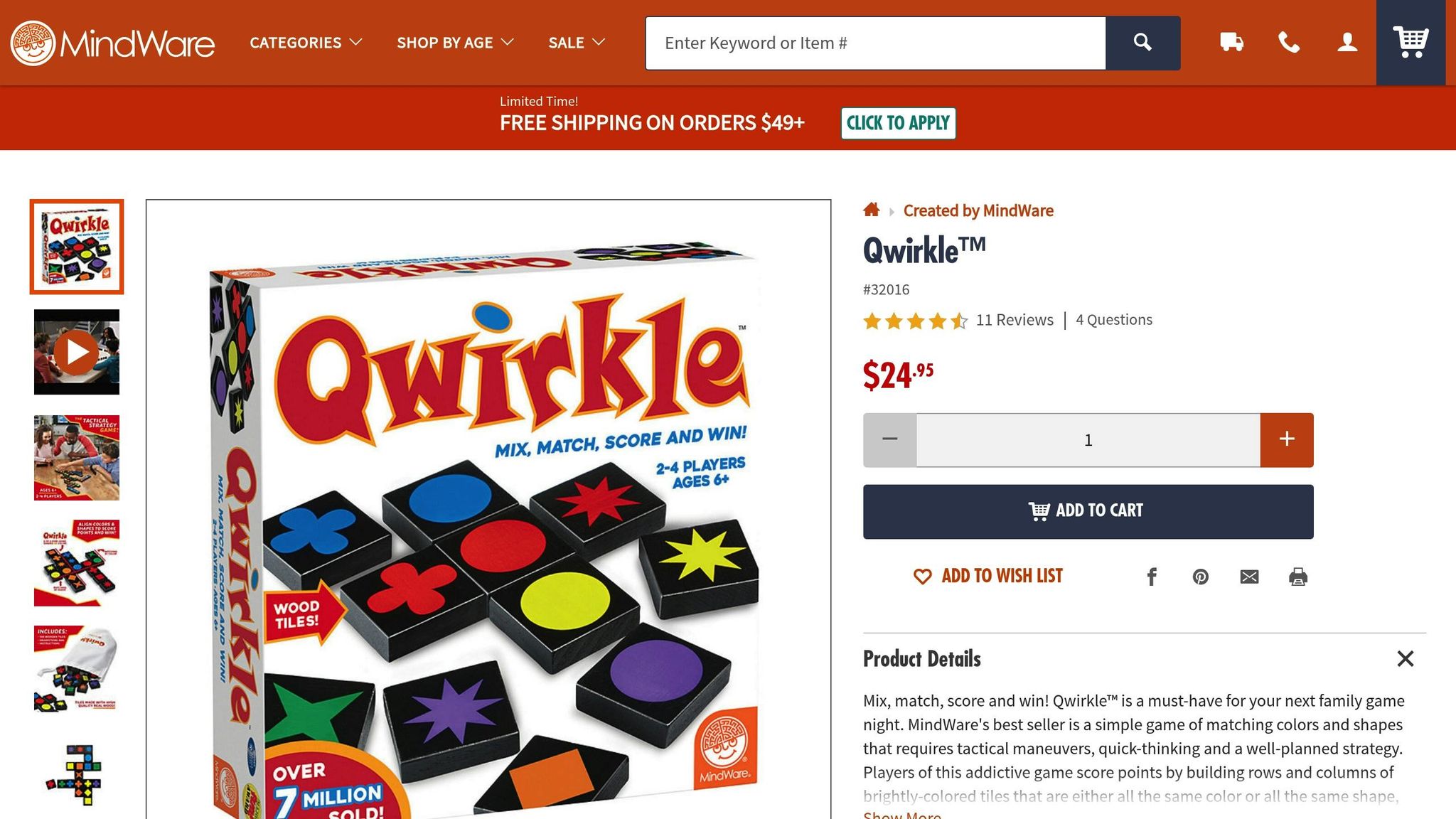
Qwirkle takes the simple concept of matching colors and shapes and turns it into a fun and strategic game suitable for players of all ages. The game features wooden tiles adorned with six different shapes in six colors. Players score points by creating lines that match either by shape or color, but there’s a catch - you can’t repeat any tile attributes in a line. This adds a layer of strategy, turning each move into a mini-puzzle.
What makes Qwirkle special is its ability to engage players with varying skill levels without altering the rules. Younger kids delight in the straightforward task of making matches, while older players often dive into the strategic challenge of planning their moves for maximum points. The tactile, colorful wooden tiles add to the experience, and because the gameplay is visual, it’s easy to play with people who speak different languages.
The highlight of the game is the "qwirkle" moment - completing a line of six tiles. It’s a thrilling achievement that happens just often enough to keep everyone excited, yet still feels rewarding every time.
Broad Age Appeal
Qwirkle is designed to adapt seamlessly to different age groups and skill levels. Officially recommended for ages 6 and up, its straightforward mechanics make it accessible to younger players, while its strategic depth keeps teens and adults engaged. The game strikes a balance where intuitive moves can sometimes outshine overly complex strategies, leveling the playing field for everyone.
Replayability
Thanks to the randomized tile draws, no two games of Qwirkle are ever the same. With 108 tiles and endless combinations, each game feels fresh. A typical round lasts 30–45 minutes, making it a great choice for family game nights. The scoring system encourages diverse strategies - whether you aim for quick points or focus on building high-scoring opportunities, there’s always room to experiment. This keeps players coming back for more.
Gameplay Dynamics
Although Qwirkle is a competitive game at its core, many families enjoy tweaking the rules to suit their preferences. Some like to play in teams, collaborating on strategies, while others create cooperative challenges, such as working together to achieve a collective score or use all the tiles. These variations add flexibility and keep the game inclusive, making it a versatile option for family gatherings.
U.S. MSRP (Affordability)
Qwirkle’s standard edition is priced at $23.99 in the U.S., offering great value for families looking for a high-quality board game. The durable wooden tiles not only enhance the playing experience but also justify the cost. For those who want added convenience, a version with trays is available for $29.99. With a 4.8 out of 5-star rating from over 18,000 Amazon reviews and 227 mentions highlighting its "value for money", Qwirkle has earned its reputation as a smart choice for family entertainment. Its mix of simple rules and strategic gameplay ensures it will be a hit at your next game night.
Cooperative vs. Competitive Play: What Works Best for Your Family?
Choosing between cooperative and competitive gameplay can elevate your family game nights and strengthen bonds. Cooperative games focus on teamwork, encouraging everyone to work together toward a shared goal. In contrast, competitive games introduce a thrilling dynamic where players face off, with one winner (or team) emerging victorious. Let’s break down how each style can fit your family’s unique vibe.
The Power of Working Together
Cooperative games shine when it comes to building teamwork and keeping the atmosphere inclusive. A great example is Richard Scarry's Busytown Eye Found It, where players join forces to complete a shared mission. These games naturally create moments to celebrate successes together, solve challenges as a group, and foster a sense of unity.
Families often find cooperative games especially fitting for gatherings that include a mix of ages. Whether it’s young kids teaming up with grandparents or teenagers helping younger siblings, these games create opportunities for everyone to contribute meaningfully. Plus, without the pressure of individual competition, the mood stays light, and conflicts are less likely to arise.
The Thrill of Competition
On the flip side, competitive games bring their own set of perks. They’re great for teaching kids how to win and lose gracefully, sharpening strategic thinking, and creating memorable moments full of excitement. Classics like Clue, Ticket to Ride, and Qwirkle challenge players’ skills while keeping the fun alive.
For a quick-paced option, Kingdomino is a fantastic choice. Players compete to draft tiles and build their kingdoms in just 15 minutes. Games like Quacks of Quedlinburg add another layer of excitement, combining risk-taking with strategic planning that appeals to all ages.
Finding the Right Balance for Your Family
Why not mix it up? A balanced game night could start with a cooperative game to set a friendly tone and warm everyone up, followed by a competitive game to amp up the energy. The key is to match the games to your family’s personality.
If frustration tends to creep in, opt for cooperative games or competitive ones with shorter rounds. For example, Bananagrams lets everyone focus on their own word grids, avoiding direct competition while still being engaging. For families who thrive on spirited challenges, Tsuro offers head-to-head action with simple rules and stunning visuals. Even if someone is eliminated, the next round starts fresh, keeping the fun going.
Adapting Games to Your Family's Needs
You can also tweak games to better suit your family. Many competitive games can be adjusted to include cooperative elements. For instance, families might create house rules for Apples to Apples Junior by working together to achieve a collective score, emphasizing shared creativity over individual wins.
Similarly, you can add a dash of competition to cooperative games by assigning roles or tracking individual contributions to the team’s success. Adjust the rules based on how your family responds. Whether you’re solving puzzles together or engaging in friendly rivalries, the ultimate goal is to create positive, memorable experiences that leave everyone looking forward to the next game night.
How Board Games Build Family Bonds and Develop Skills
Gathering around the table for a game night does more than entertain - it creates opportunities to connect, communicate, and develop essential life skills.
Communication Skills That Endure
Every game night is a chance to sharpen communication. Whether it’s explaining rules, forming strategies, or negotiating moves, players naturally practice verbal communication and learn the give-and-take of compromise. Picture a 6-year-old enthusiastically sharing their winning plan in Qwirkle or teenagers passionately debating their next move in Clue. These moments help build confidence in expressing ideas clearly.
Games like Codenames take things up a notch by encouraging creative thinking and teamwork. Families work together to decipher word clues, which fosters active listening and thoughtful responses. These interactions strengthen bonds and create meaningful connections that last well beyond the game table.
Learning Teamwork and Problem-Solving
Cooperative games are perfect for teaching families how to work as a team. Take Forbidden Island, for example. Players must collaborate to collect treasures and escape before the island sinks, making decisions together across all age groups. These experiences highlight how combining different perspectives can lead to better solutions.
The problem-solving skills gained during gameplay don’t just stay at the table - they carry over into real-world situations. Families learn to approach challenges collaboratively, a skill that’s valuable in everyday life.
Fostering Empathy and Emotional Growth
Board games also encourage families to step into each other’s shoes. By seeing situations from different perspectives, players develop empathy. For instance, when a younger sibling struggles with a tricky move in Kingdomino, older family members practice patience and offer guidance with compassion.
Games also provide a natural way to learn conflict resolution. Disputes over rules or moves teach families how to navigate disagreements calmly and effectively. Instead of sidestepping tough conversations, players learn to address challenges together in a relaxed, supportive setting.
Tailoring Games to Your Family
Choosing the right games for your family dynamic can amplify these benefits. Games that suit everyone’s age and skill level ensure an enjoyable experience for all. For families with a wide age range, Hero Kids offers simple adventures where children can take the lead while learning teamwork and problem-solving alongside adults.
Parents play a crucial role in modeling behaviors like good sportsmanship, patience, and respectful communication. When adults show how to lose gracefully or celebrate others’ successes, they’re teaching kids emotional regulation and social skills that will serve them for years to come.
Bringing Board Games Into American Family Life
It’s easy for American families to make board games a regular part of their lives. Thanksgiving gatherings can become even more memorable when generations come together over Ticket to Ride, turning a holiday into a shared adventure. Weekend game nights offer a screen-free way to connect, encouraging face-to-face interaction in today’s digital age.
Even busy weeknights can include a quick game like Bananagrams, transforming an ordinary evening into a moment of connection. And during summer reunions, games like Apples to Apples Junior bring laughter and insight into each other’s personalities.
Game Comparison Table
Finding the perfect board game for your family is easier with a side-by-side comparison. Below, you'll discover a range of games tailored to different ages, play times, and skill levels, ensuring there's something for everyone.
| Game Name | Ages | Play Time | Players | Style | Core Skills Developed | MSRP |
|---|---|---|---|---|---|---|
| Ticket to Ride | 8+ | 30–60 min | 2–5 | Competitive | Strategic planning, geography, resource management | $49.99 |
| Richard Scarry's Busytown Eye Found It | 3+ | 15–20 min | 2–4 | Cooperative | Observation, teamwork, visual recognition | $19.99 |
| Clue | 8+ | 45–60 min | 3–6 | Competitive | Deductive reasoning, logical thinking, memory | $11.99 |
| Apples to Apples Junior | 12+ | 30–45 min | 4–10 | Competitive | Creativity, vocabulary, social interaction | $19.99 |
| Quacks of Quedlinburg | 10+ | 45–60 min | 2–4 | Competitive | Risk assessment, probability, decision-making | $49.99 |
| Kingdomino | 8+ | 15–20 min | 2–4 | Competitive | Spatial reasoning, pattern recognition, planning | $19.99 |
| Bananagrams | 7+ | 10–15 min | 1–8 | Competitive | Spelling, vocabulary, quick thinking | $14.99 |
| Tsuro: The Game of the Path | 8+ | 15–20 min | 2–8 | Competitive | Strategic thinking, spatial awareness, foresight | $29.99 |
| Ghost Blitz | 8+ | 15–30 min | 2–8 | Competitive | Reaction time, visual processing, concentration | $12.99 |
| Qwirkle | 6+ | 30–45 min | 2–4 | Competitive | Pattern matching, strategic thinking, color recognition | $19.99 |
This table highlights essential details, making it easier to pick games that suit your family's preferences and schedule.
Budget-Friendly Options Under $20
Seven of the ten games listed cost less than $20, offering plenty of choices for affordable family fun. Ghost Blitz ($12.99) and Bananagrams ($14.99) stand out for their low price and engaging gameplay, making them great picks for budget-conscious families.
Quick Games for Busy Families
If you're short on time, Kingdomino, Bananagrams, and Tsuro: The Game of the Path all offer playtimes of 15–20 minutes. These games fit perfectly into a packed schedule, whether it's a weeknight activity or a warm-up for longer gaming sessions.
Large Group Entertainment
Games like Tsuro: The Game of the Path, Ghost Blitz, and Bananagrams can accommodate up to eight players. They're ideal for family gatherings, birthday parties, or holiday celebrations, ensuring everyone can join the fun.
Cooperative Learning
For families who enjoy working together rather than competing, Richard Scarry's Busytown Eye Found It is the only cooperative game in this selection. It's perfect for younger children and helps build teamwork and observation skills while fostering family connections. This aligns with the 22% of parents who prioritize toys that bring families closer together.
This collection caters to a wide range of preferences, from preschool-friendly adventures to strategy-driven games for older kids and adults. With a 10% annual rise in popularity among 6–9-year-olds, these games also meet the needs of the 21% of parents seeking toys that promote problem-solving skills. Whether you're looking for quick fun, budget-friendly options, or group activities, there's something here to make your next game night a hit.
Conclusion
Board games provide a wonderful way for families to step away from screens and spend quality time together. The ten games highlighted in this guide offer something for everyone, from helping a 3-year-old discover hidden objects in Richard Scarry's Busytown Eye Found It to engaging in strategic challenges with teens over Ticket to Ride. These games don’t just entertain - they also strengthen critical skills and foster family bonds.
Options like Qwirkle and Kingdomino grow with your child’s abilities, offering lasting enjoyment. Meanwhile, quick games like Bananagrams are perfect for squeezing in some fun during a busy weeknight. Building a collection of games that suits your family doesn’t have to break the bank, either.
Beyond fun, these games help develop critical thinking, improve social skills, and teach valuable lessons about teamwork and sportsmanship. Cooperative games, in particular, show that working together can be just as rewarding as winning.
Ready to bring more fun and learning to your family time? Check out Brain Games' complete catalog to find these titles and explore even more options for your next game night. Plus, with the Game Exchange Guarantee, you can try new games risk-free - return any title within two weeks if it’s not the right fit for your family.
FAQs
What should I keep in mind when picking a board game for a family with a wide range of ages?
When picking a board game for a family with a mix of ages, it's important to think about age appropriateness so everyone can join in and have fun. Aim for games with straightforward rules that younger players can easily follow, while still offering enough challenge to keep the adults interested.
Also, consider the length of the game - shorter playtimes often suit younger kids better. Decide if you'd prefer a cooperative game, where the family works as a team, or a competitive one that adds a bit of friendly rivalry. Choosing a theme that matches shared family interests can make the experience even more enjoyable for everyone.
How do family-friendly board games support critical thinking and social skills in children?
Board games offer a fantastic way for kids to sharpen their critical thinking abilities. Through gameplay, children learn to plan, solve problems, and think strategically. These activities help them evaluate situations and make thoughtful decisions - skills that are valuable both in and out of the game.
On top of that, board games are a wonderful tool for developing social skills. They teach kids how to take turns, communicate clearly, and handle wins and losses with grace. These lessons nurture patience, teamwork, and emotional resilience, all while bringing families together for quality bonding time.
How can we make competitive board games feel more cooperative for family game nights?
Transforming competitive board games into cooperative activities can be a fantastic way to bring the family closer. One approach is to create house rules that promote teamwork - think shared goals or opportunities for players to collaborate on strategies. You could also tweak the win conditions so that everyone works toward a common goal instead of competing for individual victories.
Another option is introducing team play by pairing up family members. This not only makes the game more inclusive for younger players but also adds a fresh dynamic to the experience. Adjusting the mechanics to focus on solving problems together or achieving shared success encourages bonding and ensures that everyone feels involved. With just a few simple changes, game night can become a fun, team-focused tradition!






